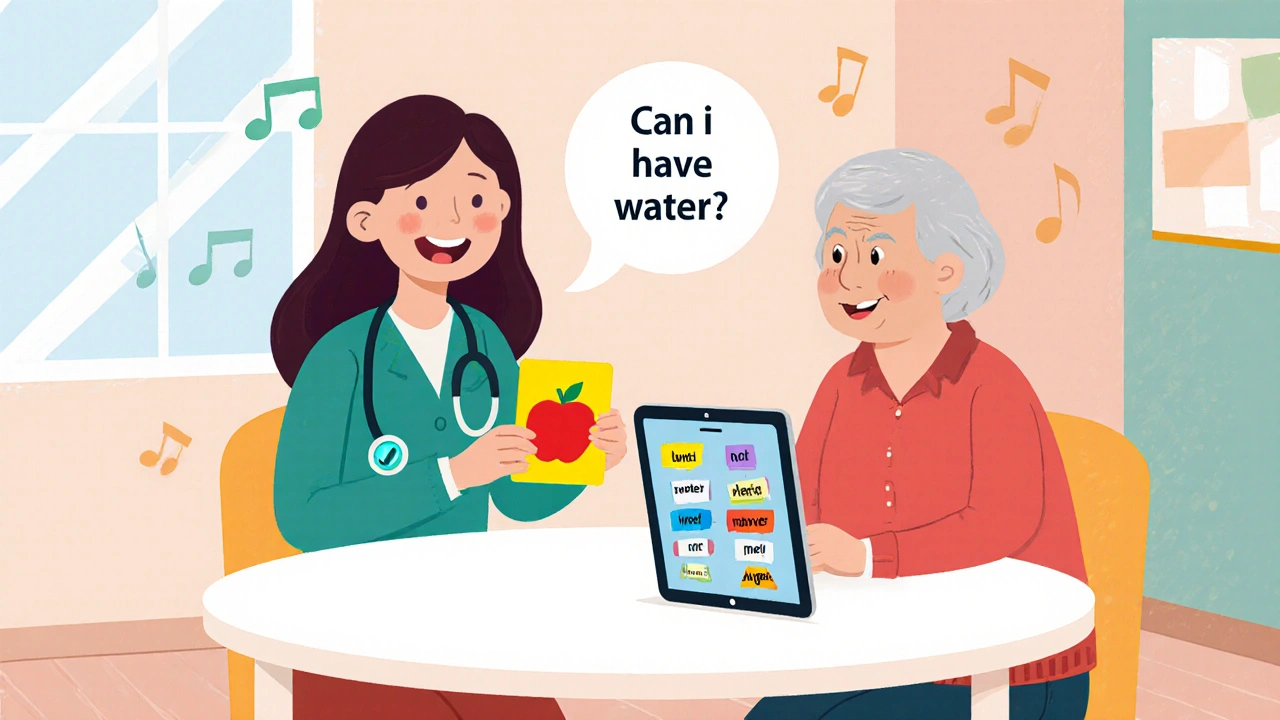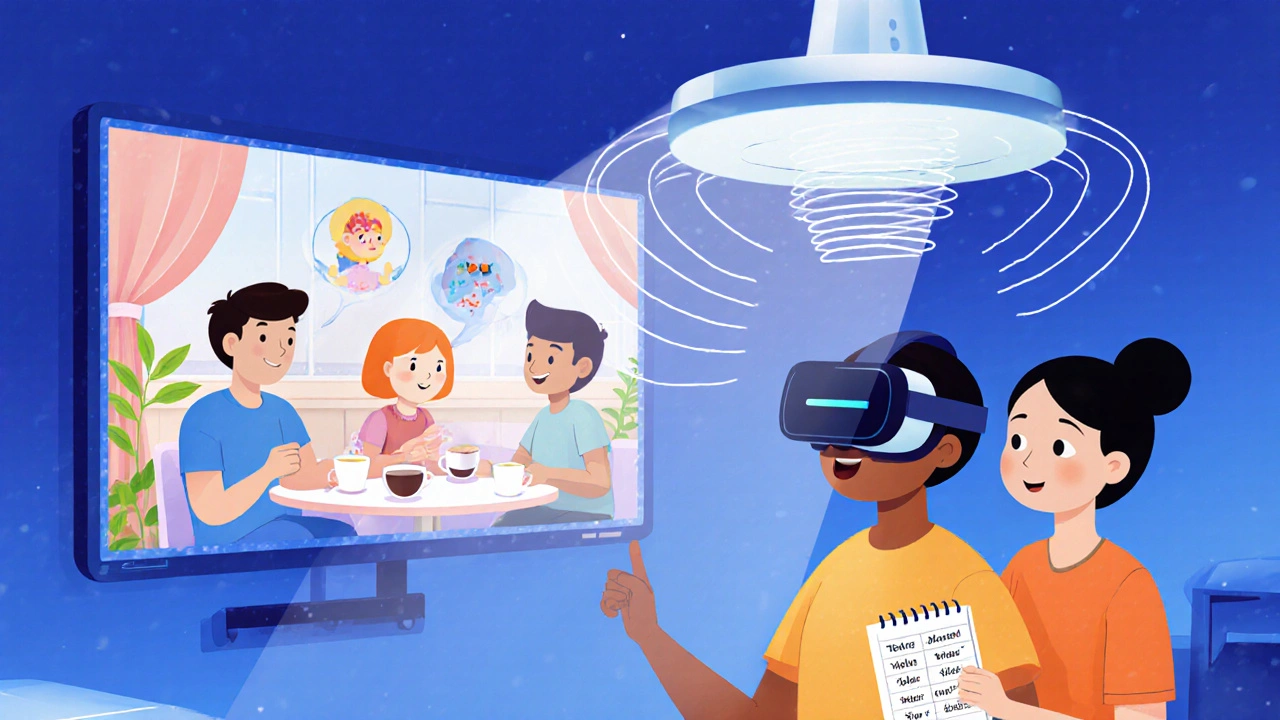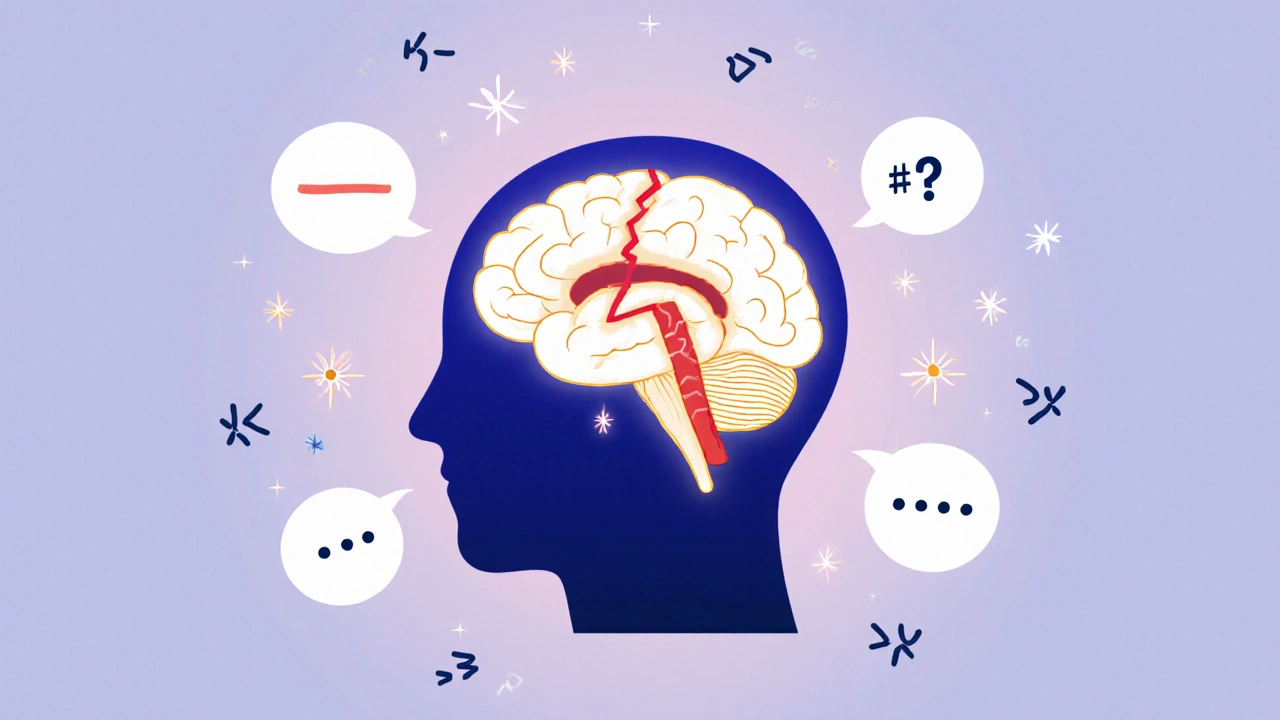When a stroke interrupts blood flow to the brain, it can damage the neural networks that let us speak, understand, and read, the world suddenly feels louder and stranger. One in four stroke survivors report trouble finding words, while another quarter notice that their sentences don’t make sense to listeners. If you or a loved one are navigating these changes, you’re not alone - and there are clear steps to regain confidence in conversation.
Why Language Falls apart after a Stroke
The brain houses specialized hubs for language. Damage to Broca's area the frontal region that shapes speech production typically slows down word formation, leading to halting speech. Harm to Wernicke's area the temporal zone responsible for language comprehension makes sentences sound fluent but nonsensical. In many cases, a stroke strikes both zones or the connecting white‑matter pathways, creating a mix of symptoms.
Beyond these classic sites, a stroke can cause:
- Dysarthria - weakness or incoordination of the muscles used for speech, producing slurred or breathy sounds.
- Apraxia of speech - a planning problem where the brain knows what to say but can’t coordinate the mouth muscles.
- Cognitive‑communication disorder - trouble with attention, memory, or executive function that messes up conversation flow.
All of these fall under the umbrella term aphasia a language impairment caused by brain injury, even though the exact label depends on which structures are harmed.
Spotting the Signs: Who Gets Affected and How
Not every stroke patient will develop language problems, and the severity varies wildly. Here’s a quick snapshot of common patterns:
- Expressive aphasia (Broca's) - speech is slow, effortful, and missing small words ("I … to the store").
- Receptive aphasia (Wernicke's) - the person speaks fluently but uses odd words or neologisms ("The sky is a fruit").
- Global aphasia - both comprehension and expression are severely limited; often seen in large‑area strokes.
- Dysarthria - voice sounds nasal, tremulous, or weak; intelligibility drops, especially on the side opposite the lesion.
- Apraxia of speech - inconsistent errors; the same word may be pronounced correctly one minute and garbled the next.
Because the brain reorganizes itself, many patients improve within weeks to months, especially with targeted therapy.
How stroke communication Therapy Works
Rehabilitation hinges on two principles: repetition and meaningful use. Speech‑language pathologists clinicians trained to assess and treat speech, language, and swallowing disorders design personalized programs that tap into neuroplasticity the brain's ability to form new connections after injury. Below are the core components you’ll encounter.
- Auditory‑verbal drills: Repeating words, sentences, and tongue‑twisters to rebuild motor patterns.
- Semantic cueing: Using pictures or category prompts ("fruit", "tools") to jog word retrieval.
- Functional conversation practice: Role‑playing phone calls, ordering meals, or talking about daily routines.
- Technology‑assisted tools: Apps like Lingraphica or Constant Therapy that offer computerized drills and progress tracking.
Therapy intensity matters. Research from the 2023 American Stroke Association suggests that 3‑hour daily sessions over the first two weeks boost word‑finding scores by 30% more than smaller, spaced‑out practice.

Practical Strategies for Families and Caregivers
Recovery isn’t limited to clinic time. Your home environment can become a low‑stress rehearsal space:
- Slow down: Give the survivor extra time to finish thoughts; avoid finishing sentences for them.
- Use multimodal cues: Pair spoken words with gestures, pictures, or written text.
- Keep a communication notebook: Write down frequent phrases, key medical terms, or emergency contacts.
- Encourage group activities: Book clubs, cooking classes, or simple board games keep language muscles active.
Patience is key. Celebrate even tiny advances - a correctly pronounced vowel or a successful request for water can lift morale dramatically.
When to Seek Professional Help
If any of these red flags appear, contact a specialist promptly:
- Sudden loss of the ability to understand simple commands.
- Persistent difficulty forming sentences beyond the first week post‑stroke.
- Swallowing problems (a common companion to speech issues).
- Emotional distress or social withdrawal due to communication frustration.
Early assessment, ideally within 48 hours of hospital discharge, improves outcomes. Many hospitals now offer tele‑speech services, allowing remote evaluation for those in rural areas.
Comparing Common Post‑Stroke Language Disorders
| Disorder | Primary Cause | Typical Symptoms | Therapy Focus |
|---|---|---|---|
| Aphasia | Lesion in language centers (Broca’s, Wernicke’s, or their pathways) | Word‑finding difficulty, jumbled sentences, impaired comprehension | Semantic cueing, sentence building, reading/writing tasks |
| Dysarthria | Weakness or incoordination of speech musculature | Slurred, breathy, or monotone speech; reduced intelligibility | Respiratory control, articulatory drills, voice strengthening |
| Apraxia of Speech | Disrupted motor planning for speech | Inconsistent sound errors, groping for the right mouth shape | Sequencing drills, timing exercises, multisensory cueing |
| Cognitive‑Communication Disorder | Damage to attention, memory, or executive networks | Difficulty staying on topic, following multi‑step directions | Memory aids, structured conversation, problem‑solving tasks |

Future Directions: Emerging Treatments and Research
Scientists are exploring ways to boost neuroplasticity the brain’s rewiring capacity after injury beyond traditional therapy.
- Transcranial magnetic stimulation (TMS): Non‑invasive pulses that stimulate the undamaged hemisphere, potentially accelerating language recovery.
- Constraint‑induced language therapy (CILT): Forces use of the impaired language system by restricting alternative communication methods.
- Virtual reality (VR) conversation training: Immersive environments where patients practice ordering coffee or navigating a grocery store.
Early trials report up to 20% faster gains when TMS is paired with intensive speech therapy, but accessibility remains limited. Keep an eye on local stroke support groups - they often host pilot studies.
Bottom Line Checklist for Stroke‑Related Communication Issues
- Identify the specific disorder (aphasia, dysarthria, apraxia, or cognitive‑communication).
- Seek assessment from a qualified speech‑language pathologist for personalized diagnosis and treatment plan within the first week after hospital discharge.
- Engage in daily, meaningful language practice - even 15 minutes of conversation counts.
- Utilize technology tools for home drills and progress tracking.
- Involve family: slow pacing, multimodal cues, and celebration of small wins.
- Monitor for red‑flag symptoms and address them early.
- Stay informed about emerging therapies like TMS or VR‑based training.
Frequently Asked Questions
Can a stroke cause total loss of speech?
Yes. When a stroke damages large portions of both Broca’s and Wernicke’s areas, the result can be global aphasia, which severely limits both speaking and understanding. Even in such cases, therapy can help regain basic communication over months.
How long does it typically take to see improvement?
Most people notice measurable gains within the first three months, especially with intensive daily practice. Continued improvement can occur for up to two years as the brain keeps adapting.
Is it normal to feel frustrated when conversation is hard?
Absolutely. Communication is tied to identity, so setbacks often trigger emotional distress. Addressing feelings with a psychologist or support group can be as important as speech drills.
Do tablet apps actually help with aphasia?
Evidence from 2022 randomized trials shows that well‑designed apps boost word‑retrieval practice frequency, leading to about a 10‑15% higher score on standardized aphasia tests compared with paper‑based home work.
What role does family support play in recovery?
Family creates the real‑world language environment a therapist can only simulate in a clinic. Consistent encouragement, reduced pressure, and structured conversation opportunities are linked to faster, more durable gains.


Comments
Karla Johnson
Having gone through a post‑stroke aphasia journey myself, I can attest that the brain’s plasticity is both stubborn and surprisingly adaptable. The first weeks feel like a fog where words float just out of reach, and patients often grapple with the embarrassment of stumbling over simple sentences. Intensive repetition, as the article mentions, really does matter; three hours a day may sound daunting, but the neural pathways light up with each deliberate utterance. It’s crucial to pair auditory drills with semantic cueing, because the brain needs both sound and meaning to rewire. Families should also remember that finishing a survivor’s sentence can inadvertently reinforce avoidance habits. Multimodal cues-gestures, pictures, even gentle touch-serve as scaffolding while the speech‑language pathologist designs a personalized plan. Technology‑assisted apps, like Constant Therapy, provide the needed dose of practice between clinic visits, and their data tracking can highlight subtle progress that might otherwise go unnoticed. Emotional support cannot be overstated; frustration is natural, yet a calm environment encourages risk‑taking in conversation. In my experience, a daily “word‑of‑the‑day” game turned a mundane routine into a meaningful rehearsal. Remember that recovery trajectories differ: some see noticeable gains within one month, while others continue to improve for years. The key is consistency, not perfection, and celebrating tiny victories-like correctly pronouncing a vowel or successfully ordering a coffee-keeps motivation alive. Moreover, emerging treatments such as TMS are promising, but access remains limited, so we must advocate for broader insurance coverage. Finally, keep a communication notebook handy; jotting down frequently used phrases can reduce anxiety during family gatherings. The bottom line is that speech recovery is a marathon, not a sprint, and every repeat counts toward a richer, more confident life.
October 18, 2025 at 20:20
Ayla Stewart
I appreciate the clear breakdown of each language disorder and the practical tips for home practice. Keeping conversations slow and giving extra time really helps the survivor feel heard. Using pictures alongside words is a simple but effective cue. It’s also good to know that early assessment within 48 hours can improve outcomes.
October 29, 2025 at 09:20
alex montana
Wow!!! This article really hits the nail on the head!!! Stroke survivors often feel like they’re trapped in a fog of words! The list of symptoms is spot‑on, and the therapy suggestions are gold!!! I can’t stress enough how important it is to not rush the patient!!!
November 8, 2025 at 23:20
Wyatt Schwindt
Patience and steady practice are key.
November 19, 2025 at 13:20
Fabian Märkl
Hey everyone! 🙌 If you’re supporting a loved one after a stroke, remember that even 15 minutes of playful chat can spark big gains. Try turning word drills into a game-maybe a quick “Name that object” challenge during dinner. Celebrate every tiny win, and keep the vibe upbeat. You’ve got this! 🚀
November 30, 2025 at 03:20
Natala Storczyk
Enough of the sugar‑coated advice!!! In America we need real, hard‑core therapy, not just cute games!!! Push for the three‑hour intensive sessions now, or we’ll keep losing our national vigor!!!
December 10, 2025 at 17:20
nitish sharma
Esteemed colleagues, I would like to commend the comprehensive overview provided herein. The delineation of aphasia subtypes is both precise and pedagogically sound. It is imperative that caregivers adopt a systematic approach, integrating auditory‑verbal drills with semantic cueing. Moreover, the incorporation of technology‑assisted platforms should be pursued with due diligence, ensuring data privacy. I trust that these recommendations will facilitate substantive improvement in post‑stroke communication outcomes.
December 21, 2025 at 07:20